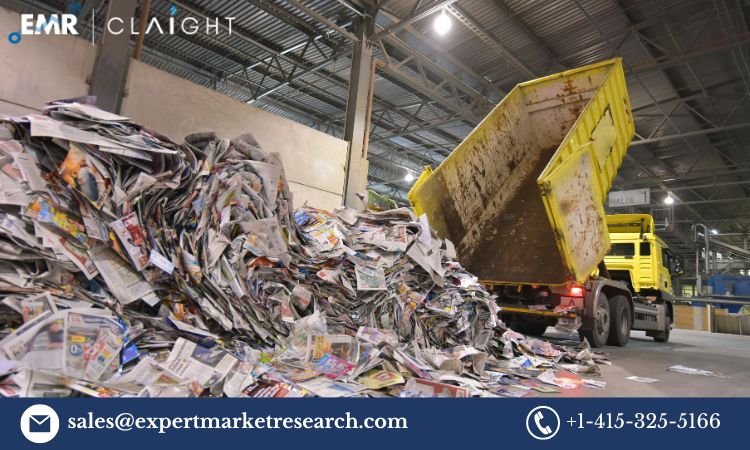Market Overview
The global Recovered Paper Market Size is a vital segment of the recycling industry, providing sustainable solutions for the production of new paper and packaging materials. In 2024, the market reached a volume of approximately 277.08 million metric tons, driven by growing environmental concerns and regulatory mandates promoting recycling. The industry is projected to grow at a compound annual growth rate (CAGR) of 2.5% between 2025 and 2034, underpinned by increased demand from packaging, printing, and other industrial applications.
Recovered paper refers to post-consumer and post-industrial paper waste collected, processed, and recycled into new paper products. This market plays a pivotal role in reducing deforestation, conserving energy, and minimizing landfill waste, aligning with global sustainability goals.
Key Benefits of the Recovered Paper Market
- Environmental Sustainability:
- Recovered paper recycling reduces the need for virgin pulp, conserving forests and reducing carbon emissions associated with logging and processing.
- Energy and Cost Efficiency:
- Recycling paper consumes significantly less energy and water compared to producing new paper from raw materials, resulting in cost savings.
- Waste Management:
- Diverts paper waste from landfills, reducing methane emissions and landfill space usage.
- Economic Opportunities:
- Creates employment opportunities in collection, sorting, and recycling industries.
- Compliance with Regulations:
- Enables businesses to comply with stringent environmental regulations and achieve corporate sustainability targets.
Key Industry Developments
- Technological Advancements:
- Innovations in sorting and deinking technologies are improving the quality of recycled paper, enhancing its suitability for high-grade applications.
- Circular Economy Initiatives:
- Governments and corporations are increasingly adopting circular economy practices, emphasizing the reuse of materials like paper.
- Expansion in Emerging Markets:
- Developing countries in Asia and Africa are investing in recycling infrastructure, bolstering the supply of recovered paper.
- Collaborative Industry Efforts:
- Partnerships between waste management companies and manufacturers are streamlining collection and recycling processes.
Driving Factors
- Rising Demand for Sustainable Packaging:
- The surge in e-commerce and the phasing out of single-use plastics have fueled demand for recycled paper-based packaging.
- Stringent Environmental Regulations:
- Policies encouraging waste reduction and recycling are pushing industries toward recovered paper usage.
- Cost Benefits:
- Recovered paper is often more economical than virgin pulp, driving its adoption across various industries.
- Consumer Awareness:
- Growing consumer preference for eco-friendly products is influencing manufacturers to use recycled materials.
Restraining Factors
- Quality Concerns:
- Variability in the quality of recovered paper can limit its application in certain high-grade products.
- High Processing Costs:
- Costs associated with sorting, cleaning, and deinking can be substantial, impacting profitability.
- Export Restrictions:
- Policies restricting the export of waste paper in certain countries can affect global supply chains.
- Competition from Alternative Materials:
- Materials like plastics and bio-based alternatives may challenge the growth of recovered paper.
Market Segmentation
- By Grade:
- Mixed Paper: Used for low-grade products like newsprint.
- Old Corrugated Containers (OCC): Widely used in packaging.
- Deinked Pulp: Utilized for printing and writing papers.
- High-Grade Paper: Recycled into fine paper products.
- By Application:
- Packaging: Corrugated boxes, cartons.
- Printing and Writing: Newspapers, office paper.
- Hygiene Products: Tissue papers, paper towels.
- Others: Industrial and specialty uses.
- By End-User:
- Industrial: Manufacturing and packaging sectors.
- Commercial: Retail and e-commerce.
- Residential: Household waste collection.
Market Outlook
The recovered paper market is poised for steady growth, with key drivers including increasing environmental awareness and regulatory support. Advancements in recycling technologies and the growing demand for sustainable packaging will likely sustain market momentum. However, addressing quality concerns and improving the efficiency of recycling processes remain critical challenges.
Trends in the Industry
- Automation in Recycling Plants:
- Deployment of AI and robotics for efficient sorting and processing.
- Urban Mining:
- Recovering valuable materials from urban waste streams, including paper.
- Focus on Closed-Loop Systems:
- Encouraging manufacturers to recycle their paper waste into new products.
- Growth in Digital Technologies:
- Digital platforms for waste collection and recycling are simplifying supply chain management.
Regional Analysis/Insights
- North America:
- Leading in advanced recycling infrastructure and strong regulatory support.
- Europe:
- High recycling rates driven by stringent EU directives and consumer awareness.
- Asia-Pacific:
- Rapid industrialization and urbanization are driving demand, with China and India leading the market.
- Latin America:
- Emerging market for recovered paper with growing investments in recycling.
- Middle East & Africa:
- Gradual adoption of recycling practices amid increasing environmental concerns.
Top Impacting Factors
- Policy Changes: Regulatory shifts affecting waste paper collection and usage.
- Global Supply Chain Dynamics: Fluctuations in waste paper availability and pricing.
- Technological Innovations: Advances in recycling methods improving efficiency and quality.
Target Audience
- Paper Manufacturers: Seeking sustainable raw materials.
- Packaging Companies: Transitioning to eco-friendly solutions.
- Waste Management Firms: Collaborating for efficient recycling.
- Policy Makers: Driving regulations for a sustainable future.
- Environmental Organizations: Advocating for recycling initiatives.
Major Key Players
- Waste Management, Inc.
- Smurfit Kappa Group
- DS Smith Plc
- Republic Services, Inc.
- Cascades Inc.
- SUEZ
- Others
Opportunities
- Emerging Markets: Untapped potential in developing regions.
- Technological Integration: Adoption of AI and IoT for optimized recycling.
- Collaborative Models: Partnerships between governments and private players.
- Product Innovation: Development of high-grade recycled paper products.
Challenges
- Logistics Issues: Collection and transportation inefficiencies.
- Market Volatility: Price fluctuations of recovered paper.
- Regulatory Hurdles: Complex compliance requirements.
- Contamination of Waste Streams: Reducing the recyclability of collected paper.
Restraints
- Limited Recycling Infrastructure: Especially in underdeveloped regions.
- Dependency on Import-Export Dynamics: Fluctuations in global trade policies.
- High Capital Requirements: For setting up advanced recycling facilities.
Scope of the Market
The recovered paper market holds immense potential in addressing environmental challenges and supporting global sustainability goals. With increasing investments in recycling technologies and growing awareness among consumers and businesses, the market is set to expand its scope across industries, including packaging, printing, and hygiene products.
The recovered paper market is an integral part of the global effort to transition toward a sustainable and circular economy. Despite challenges such as quality concerns and regulatory complexities, the market’s growth prospects remain promising, driven by robust demand for eco-friendly materials, technological advancements, and supportive policies. Key players and stakeholders must collaborate to overcome barriers and unlock the full potential of the recovered paper industry, contributing to a greener future.












Leave a Reply